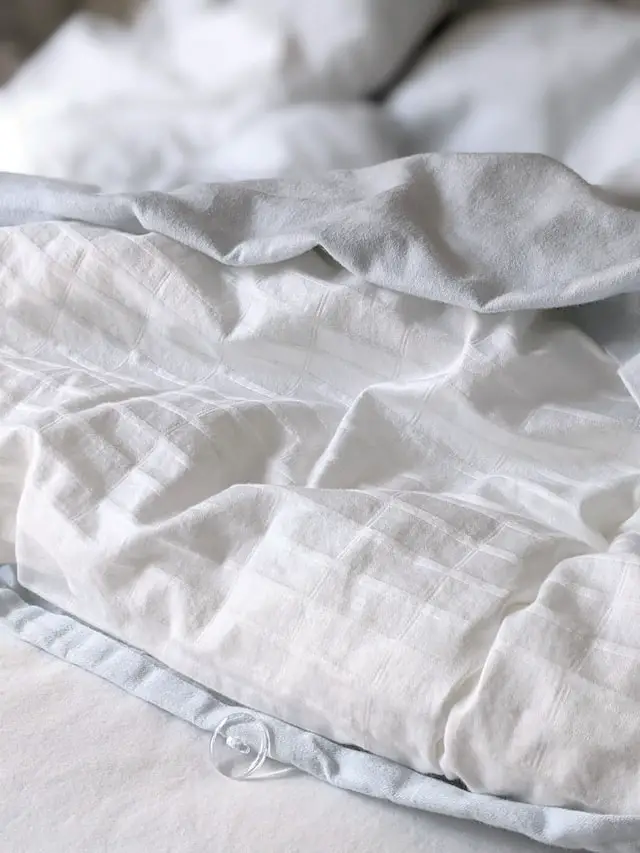Because of its big size, the idea of washing a polyester comforter might sound scary. But the truth is, washing a comforter is an easy and straightforward business. There are many different ways you can achieve that, from home cleaning to even employing the services of a professional.
Below, we’ll walk you through the entire process of washing a polyester comforter.
Check the care label
The first and foremost thing to consider when washing a polyester comforter is the care label. Most polyester comforters that come from a reputable and quality brand will definitely come with a care label that will tell you exactly how to clean the comforter and sometimes how to maintain it.
It is of paramount importance to go through the fabric care label because comforters can be filled using different types of materials from down alternatives to down itself, feathers and even natural and synthetic fibers, and not all of these things can be successfully cleaned in the washing machine or immersed in water.
Some of them, like silk fillings, can be damaged by excessive agitation, which is why you should always go through the label to be properly informed.
In the washer
After you’re 100% sure that the care label of your polyester comforter recommends machine or hand washing, you can proceed with the next few steps and instructions on how to clean your comforter.
Dust it
The first thing you want to do is to take the comforter and dust it property. It’s always the case that dust and little particles have accumulated on it and you don’t want those going through the drainage system or pipes of your washer so that the chances of a possible blockage is minimized.
Treat stains
If you have stains on your polyester comforter, now is the right time to tackle them. Different ways and products exist on how to treat different types of stains, but the most likely types of stains you’ll find on polyester comforters are stains from soil and sand, sweat stains, blood stains as well as urine stains.
Fresh stains (and also sand and soil based stains) can easily be removed when you launder the comforter immedietly, but for set in stains, you might have to use a product specially formulated to tackle the soecific type of stain you have.
Before treating stains on polyester comfroter using a stain remover, do a quick test in an inconspicious area to find out how the material will react with the product. Use the product as directed by the manufacturer for the test, and only proceed when the polyester returns no reaction after drying completely.
Put it in the wash tub
When you’re sure you’ve tackled stains to the best of your abilities, you can let the washing machine do the rest of the work.
If you never had stains in the first place then great news!
Now proceed to fit the comforter into the wash tub and make sure it perfectly fits into it, and isn’t a tight fit. If it’s indeed a tight fit, remove the comforter and take it to the laundromat. Trying to force a wash will be a terrible idea because the comforter wont wash properly.
It’s not only the washer you should be checking to see if the comforter fits into it’s wash tub seamlessly, check the dryer too, and the latter is extremely important. If your polyester dosent fit into the dryer seamlessly, then forget washing it at home. Take it to the dry cleaners or a wet wash service.
Trying to dry it in a tight confinement can cause wcorching or even distortion of the conforter. And besides, the fillings inside wont dry properly and you’ll be left with moist spots that can mildew.
Do an extra rinse cycle
So you’ve got the comforter properly dusted, you’ve put it in the washing machine and it fits perfectly, and so also the dryer, now you want to set the washer for a cycle.
Opt for cold water wash: because cold water is the most gentlest of all water temperatures and as such will not lead to problems like shrinkage of your comforter, and chose the gentlest cycle possible.
A gentle cycle is important because most comforters have fillings inside of them with internal battles that seperate these fillings, and these baffles arent made from the most durable material in the world, so the weight of the fillings inside can cause tearing of the baffles which will destroy the structure of the area affected.
For detergent, use a mild detergent, or go for one that can tackle the specific type of stain you’re trying to remove.
Run a wash cycle with detergent and a second wash cycle without detergent, so you end up with three rinses at the end of the day which will help eliminate suds in the inside and outside of the comforter.
In case you didnt know, leftover suds, especially on down or feather can clump them and cause them to weigh the duvet down. And they can also trigger allergy in sensitive people.
Put it in the dryer
After washing, it’s time to dry. A drying machine is so much better than air drying because it will eliminate moist spots, dry the conforter faster, and also help it revive back the fluff.
With air drying, it’s easy to have moist spots left after drying which can mildew or smell, and forget about getting fluff back, unless you try to fluff back the comforter mid way drying using a badminton racket or something with a bit of surface to it.
So, how do you dry a polyester comforter? As simple as ABC, put it in the dryer and run a moderate cycle. For larger comforters like king size comforters, you might have to run a few more cycles yo get it completely dried, whereas smaller comforters require less.
As the comforter dries, take it out between cycles and fluffy it up with your hands to help with the de-clumping process which will aud the drying process overall. And alternative is to put a dryer ball or clean tennis ball and let it do the job for you.
After drying, lay the comforter flat on the bed and let it air dry for some time before folding it to store or putting it back into it’s cover.
By Hand
If you have a dirty conforter but don’t have a washing machine or dryer at home, you can wash by hand.
What you want to do is to fill a bathtub with water and then add a quality detergent to it. Swish and swirl to incorporate the detergent into the wash water then proceed to soak the comforter in the solution for about 20 to 30 minutes or longer, depending on how soiled it is.
Take out the comforter and use a very soft sponge to scrub around the surface to remove soil and stain and then go ahead to rinse. Dry in the machine afterwards.
Air dry it
If you do not have a dryer and dont have money for the laundromat or professional cleaning, fine, you can resort to the last option which is to air dry.
Air drying can lead to problems like persistent moist spots that can mildew and smell and also comforters that return flat after drying.
You can easily avoid the former by allowing the comforter to dry for a very long period of time (even directly under the sun), and the latter by fluffing up the duvet mid way drying.
In the Laundromat
I mentioned earlier that if you do not have a big capacity washer or dryer, you can always use the services of a laundromat.
When you get to the laundromat’s, the first thing to do is to make sure that you check the dispensers and make sure that there aren’t leftover products that can cause damage to the comforter.
So you’re watching for items like fabric softener and of course bleach. White polyester on a normal day can be bleached any time with chloring bleach, but because it’s now wraping a much delicate material inside, it’s not recommended.
After checking the dispensers, you’re free to go ahead and wash the comforter like you would at home.
How often to wash a polyester duvet
So now that you know how to wash your polyester comforter, how often should you do it?
The thing is, your comforter, so long you’re using a cover alongside it, shouldn’t lose freshness faster. If you have sheet between the comforter and your body, you can get away with washing your polyester comforter only three times in a year, and the cover once every week, with disinfection once in a month.
If you don’t have sheets on them however, then you should wash the comforter at least once in two months although that can cause it to degrade quickly.
Final Thoughts
If you find that your polyester comforter needs washing, then dont hesitate to put it in the washer provided that the care label says it’s permissible. Or you can opt for the services of the laundromat, wet washer, dry cleaner or even wash it by hand.
The washing machine is easier at home because it eliminates the need for elbow grease. Make sure to check that the polyester fits comfortably into your washer and drying machine as a tight fit will cause poor washing and drying respectively.



